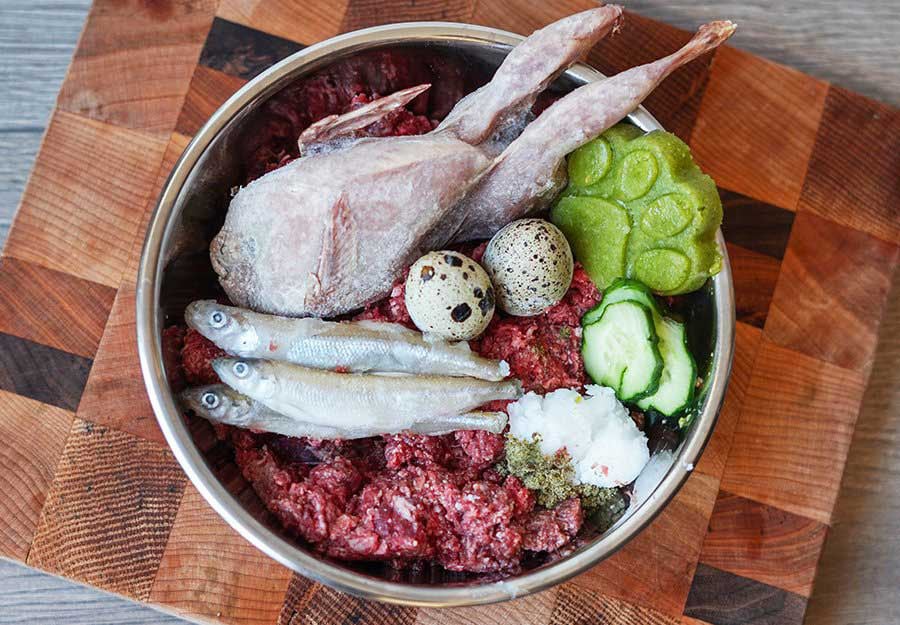
So you want to feed your dog a raw diet, but maybe you aren’t sold on all the raw brands that seem to be crawling out of the woodwork. Or maybe you just can’t find ready-made natural raw dog food recipes for your dog’s needs.
Homemade natural raw dog food recipes might be exactly what you are looking for and can be just as complete and balanced as store-bought food.
We all want what's best for our pets, but when it comes to dog food, there is no one-size-fits-all option. Even worse, it’s hard to know exactly what your dog's needs are and whether or not your current food is supplying what they need to thrive.
From the barf diet for dogs to natural raw dog food recipes- there are many different options to try on your pup. But much like any other diet, there are some cons to feeding your dog raw food.
In this article, we’ll walk you through the basics of homemade raw dog food and break down some simple homemade raw food recipes for your pooch.
You'll learn what your dog’s food needs are and how to make sure their diet is complete and balanced with things dogs love, like meaty bones, tasty organ meats, and the right mix of nutrients from real and raw ingredients.
Once you learn how to make raw dog food, you will find yourself saving time and money with a healthy dog raw food diet plan. Let's explore the feeding raw food diet for puppies and how to raw feed your dog.
The Power of Fresh
By now, I’m sure you’ve heard about the benefits of feeding raw food to your dog. Feeding whole and unprocessed food ingredients will provide your dog with the most natural and highly digestible sources of its essential nutrients while encouraging strong immune systems.
With the right raw dog food plan, your pup will reap endless nutritional benefits for a healthy life.
-
- Better Digestion
- Shinier and Healthier Skin and Coat
- Smaller and Consistent Bowel Movements
- Healthier Eating Habits
Nutrients from fresh, raw ingredients are left in their natural state, making them easier to digest and absorb. Even if you aren't ready to commit to a fully raw dog food recipe, adding fresh foods to your pet's diet can still help improve your pet's health.
Check out our Beginners Guide to Raw Dog Food to learn more about the benefits and best practices of a raw dog food diet.
Why Feed Your Dog Homemade Raw Food?

Raw diets have become increasingly popular over the past decade. There are tons of commercially made raw dog food diets available, but even with the variety of choices out there, you may need or want more control over what you feed your pet.
The practice of making your own pet food has grown with the rise in allergies, digestive system issues, diabetes, food recalls, and the recent FDA statements regarding heart disease.
Pet parents are more concerned than ever about what is in their pet’s food, so they are looking at homemade foods for a better diet solution.
Homemade and natural raw dog food offers you the peace of mind that you are feeding exactly the ingredients that your dog will thrive on, and gives you total control of the sourcing and preparation of them.
Customizing Your Dog's Homemade Raw Diet
Learning how to make dog food for your raw fed dog can be challenging and can be done incorrectly. Before you can start crafting a raw diet for your dog at home, you need to make sure that you understand what your dog needs from its diet.
Beyond your dog's basic nutritional requirements, their age, weight management, activity level, and any extenuating circumstances all need to be considered while crafting the formula.
Age

Your dog’s age will affect the quantity that you feed but may also indicate a need for different levels of fat, fatty acids, and many other essential nutrients. A puppy, for example, will require more calories during growth stages and an increase in omega fatty acids DHA and EPA to support cognitive development.
Their skeletal structure is another important factor when making homemade raw dog food in Canada. All dogs need both calcium and phosphorus to support their bones, among other systems in their body. The typical ratio of calcium to phosphorus for adult dogs is 1:1.
During growth periods, puppies have a higher requirement for calcium and phosphorus- up to three times that of adults. Large breed puppies specifically need an adjusted ratio of 1.2:1 to support bone development.
Meat is higher in phosphorus than calcium, so bone or another natural form of calcium may need to be included in the diet to achieve the correct ratio.
With a homemade diet, you can balance these important nutrients over time. Feeding additional bone, meat, or organs can supplement some of these essential nutrients without complicating your day-to-day raw recipe routine.
Health Conditions
Dogs with certain illnesses, such as diabetes, leaky gut syndrome, or other conditions that affect digestion, may need different formats of homemade raw dog food. Removing carbs or sugary ingredients can aid in blood sugar regulation and reduce harmful bacteria in the digestive tract.
A homemade raw diet will give you complete control over what goes into your dog's body. You can avoid problematic ingredients and monitor and adjust your dog's homemade raw diet on the fly.
BARF Diet Format
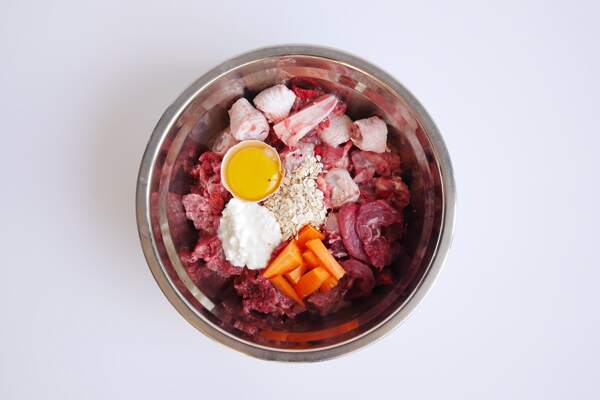
The BARF diet is the foundation of raw dog food diets as we know them.
Yep, that’s right, I said BARF. Don’t worry, it’s not as nasty as it sounds.
It’s an acronym. BARF originally stood for Bones And Raw Food but has been modified to Biologically Appropriate Raw Food. Its core principle is to feed as nature intended, just like their wild canine ancestors.
BARF Diet Principles
The BARF model is the diet that gets started with the raw feeding movement. Technically the concept of the BARF diet was around long before commercial kibble diets, but it wasn’t truly established and coined until the late ’90s by Dr. Ian Billinghurst, an Australian veterinarian and leader in the raw pet food industry.
In 2001, he published his third book entitled, “The BARF Diet,” which launched the concept of raw feeding to the general public. Since then, raw feeding has become much more widely accepted as a natural and safe feeding practice for dogs and cats.
The BARF diet isn’t a chicken recipe per se. Instead, it’s a guideline that can be modified to accommodate your pet’s needs, your preferences, and the availability of ingredients. It heavily promotes rotational feeding to provide the best variety and sources of each of their essential nutrients.
BARF Diet Breakdown
The ratio is simple, and the ingredients are generally interchangeable. If you switch from a kibble, gently cook, or heavily processed diet, the BARF diet will be the best way to test your canine culinary skills and see how your dog adjusts.
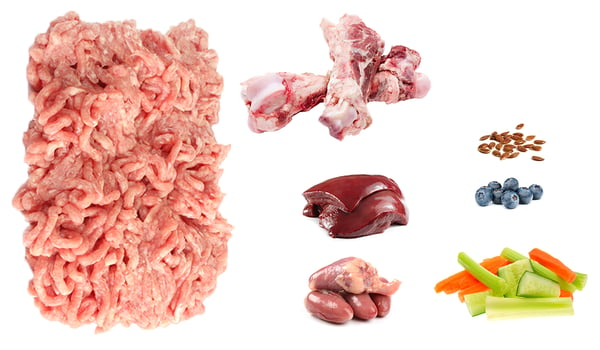
Here are the basics of a BARF meal plan:
-
- 70% lean muscle meat
- 10% raw bone
- 5% liver
- 5% other secreting organs (kidney, heart, pancreas)
- 7% vegetables
- 2% seeds or nuts
- 1% fruit
Rotating proteins is the most important part of feeding raw diets, as each animal protein has a different make-up of amino acids, minerals, and fatty acids. We recommend feeding a different protein each week or two when creating a meal plan.
You can also rotate in supplements, tripe, eggs, bone broth, and many more nutritional aids throughout your week.
In fact, one of the best ways to prepare homemade raw diets for dogs is in large batches. You can prepare batches of raw diets that will last the whole week, which will allow you to measure each ingredient in larger, more manageable portions.
1% fruits each day for a small dog could be as few as 1 blueberries in each meal, but balanced over the week, you can add in 2-3 ounces of blueberries or split that amount between 2-3 different fruits to provide more variety.
It also allows you to feed certain parts of the balanced diet separately from every meal. Bone, for example, can be fed as a treat instead of grinding it or feeding bone at each sitting. Make sure that you are feeding edible raw bones if you choose to feed them whole.
B.A.R.F. Diet for Puppies
Puppies in the wild eat very similarly to their mothers, but that doesn't mean they don't have some additional dietary needs. Puppies need additional calcium and phosphorus during the growth and development stages to help their skeletal structures grow.
With a few slight tweaks to the original B.A.R.F. model, you can craft a homemade raw diet for your puppy that will help them thrive. Here are the adjusted diet ratios for puppies:
-
- 60% lean muscle meat
- 15% raw bone
- 7% liver
- 7% other secreting organs (kidney, heart, pancreas)
- 7% vegetables
- 3% seeds or nuts
- 1% fruit
The ingredients between the two are the same, but minor adjustments to the quantity of each will ensure your puppy gets the additional nutrients required to grow. As your puppy reaches full serving size, you can easily transition them to the original BARF diet.
The Whole Prey Model
The second iteration of the balanced best raw food for dogs is called the Whole Prey Model. The idea is to mimic the ratios your pet would eat if it were hunting its wild food. It’s an offshoot of the original BARF diet with some minor adjustments.
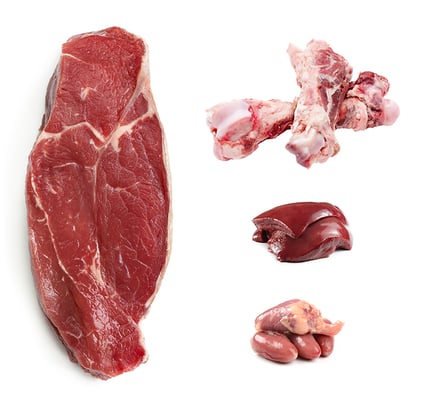
The ratio for this is pretty simple:
-
- 80% muscle meat
- 10% raw bones
- 5% liver
- 5% other secreting organs (kidney, heart, pancreas)
You may have noticed that this model doesn't include fruits, veggies, nuts, or seeds. While these ingredients are beneficial, they are not strictly required as long as you frequently rotate animal proteins and supplement them with omega fatty acids and kelp.
This balanced diet format is often preferred for pets with allergies or allergy symptoms, digestive issues, or illnesses that require carbohydrate or dietary sugar restrictions.
It’s also great for pet owners who want total control over their pet’s diets. health supplements, produce, and other ingredients can be added or adjusted to best suit your pet’s needs, or they can be fed intermittently.
Fruits and vegetables can be fed less frequently, in smaller portions, or even as occasional treats instead of adding them to their meals. Eggs, tripe, or other supplementary ingredients can be rotated throughout the week or fed as treats as well.
Dogs with more sensitive digestion may benefit from a small amount of healthy fibre, like pureed pumpkin or even sweet potatoes. This will help to regulate the speed of digestion and improve bowel movements in dogs that are inconsistent.
Wild dogs do eat vegetation, but not consistently and only as needed. This is why we call dogs scavenging carnivores. They eat what is available, meaning frequent dietary changes with a variety and quantity of nutrients.
Homemade Raw Dog Food Recipes Calculator
If you want to try out one of these homemade raw diets for your dog, check out our calculator to help you build a base recipe. This calculator will help you understand how much you'll need of each ingredient based on how many days of food you want to prepare at a time. Give it a try:
Homemade Raw Dog Food Calculator
If you are interested in making your dog's raw diet at home, then this calculator will help you create balanced and complete meals based on your pet's daily feeding guidelines.

Not sure how much your dog's daily feeding guidelines are? We have a calculator for that too!
Ingredients
The BARF and PMR diets are recommended for homemade raw diets, but the ingredients you choose are up to you. Additionally, you can change up your ingredients batch to batch to provide maximum nutrient variety.
To help, we put together a breakdown of ingredients you can choose from. These are far from all of your options, but these are some of the most common:
Muscle Meat
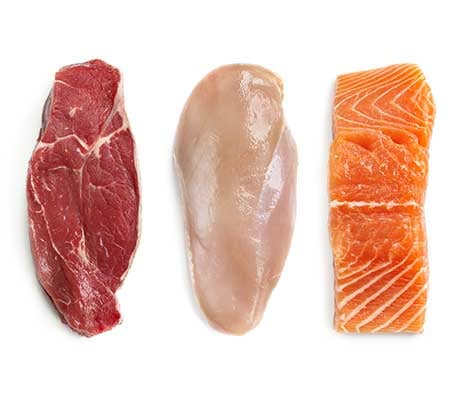 You can feed any animal protein or mix a couple together. Chicken livers, turkey, beef, and fish are the most popular options, but you can rotate in more novel proteins like lamb, pork, rabbit, and venison if they are available.
You can feed any animal protein or mix a couple together. Chicken livers, turkey, beef, and fish are the most popular options, but you can rotate in more novel proteins like lamb, pork, rabbit, and venison if they are available.
Ground meats are easiest to work with, but whole cuts of meat are fine too. Which you choose will be based on how your dog eats. Smaller breeds, those missing a few teeth, and picky eaters might be better suited to ground meat bases. These meals will be easier to pull apart and chew down.
Large cuts of muscle meat are ideal for larger breeds, especially those that tend to hoover their food. Whole pieces of meat force them to slow down and chew their food better.
Remember that some protein sources will be fattier than others. Pork, for example, is typically high in fat, but this can be mitigated by purchasing lean ground beef or lean ground pork instead of using whole cuts.
Healthy fat from the meat isn't bad, but a consistently high-fat diet may not be ideal for every dog, especially those that are considered low activity. It's better to use a mix of fatty and leaner meats for most average dogs and stick to lean cuts for chunky and low-activity dogs.
Edible Bone
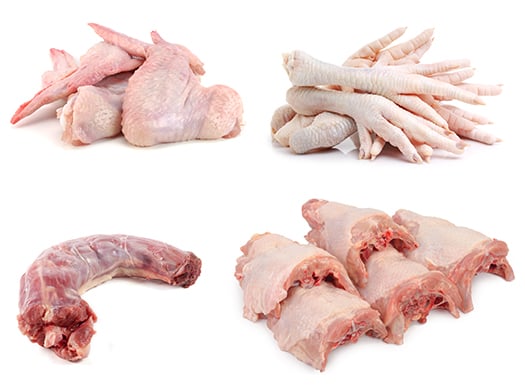
Bone inclusion is usually the area where most beginners struggle. This is because they are not sure what type of bones to choose or how to incorporate them into meals. To get you to get started, you first need to know what an edible bone is.
There are two types of bones, edible and recreational.
Edible Bone
Edible bones are softer and have a high cartilage content, making them easy to chew down without the risk of tooth damage or splintering. These include:
-
-
- Chicken necks, feet, wingtips, or backs
- Turkey necks
- Rabbit feet
- Pork tail
-
Recreational Bone
The other type of bone is called recreational bone. As the name suggests, these are bones designed for fun and activity as opposed to nutrition. Many red meat bones fall into this category. Here are some of the most popular:
-
-
- Beef Bones
- Bison Bones
- Lamb Bones
- Kangaroo Bones
-
Recreational bones provide some nutrition but are often much too tough for dogs to chew down safely, so they aren't the type of bone recommended as part of a homemade diet.
Fresh Produce
There are tons of dog-safe fruits and veggies to choose from but don't lock your dog's diet down to one choice. Variety is the spice of life. In this case, it's the key to a diverse and abundant selection of key nutrients.
A good tip is to think about colour. Brightly coloured produce is rich in micronutrients like antioxidants and essential vitamins and minerals, so try to get a good variety of colour spectrum.
Here are some common examples that you can rotate into your dog's homemade raw meal plan:
.webp?width=792&height=1633&name=best-fruits-veggies-raw-food%20(1).webp)
Variety is a great way to provide your dog with plenty of natural nutrients, which is why we put together such a long list of possibilities for your dog's homemade raw dog diet. Remember that veggies, and especially fruit, are a small portion of your DIY raw dog food.
Some parts of the fruits and veggies are unsafe for dogs and cats, so make sure you know how to safely feed different produce. Peels, cores, and seeds can range from hard to digest to extremely toxic.
For example, the skin and seed of an avocado contain persin, a toxin for dogs and cats. Only the ripe flesh should ever be fed to your dog. Even the flesh can contain small amounts of persin that leech from the seed, so this is one fruit that should be fed quite sparingly.
Other fruits and veggies are high in natural sugars like corn and bananas, and though they provide plenty of vitamins and fibre, excessive sugars can lead to digestive problems if you feed too much.
Here are a couple of resources that can help you choose the best fruits and veggies and learn how to properly prepare them for your pet:
Organs
Organ meats are typically chosen based on availability. Some are easier to source than others. The liver should be 5% of your organ meat selection, but the other 5% can be a mix of other secreting organs.
Secreting organs are some of the most nutrient-dense parts of the animal. Though only required in small portions, this part of the raw diet will supply a large variety of vital nutrients like minerals. We recommend a mix of at least two secreting organs. Here are the options you can choose from:
-
- Kidney
- Spleen
- Heart
- Pancreas
- Testicles
- Ovaries
Of these options, the kidney and heart are typically the easiest organs to source, either from your local grocery store or a butcher shop.
Beef and chicken liver or chicken hearts can be found relatively easily, but turkey, lamb, and other novel proteins may be offered through specialty butcher shops or from farmers who sell directly.
Seeds/Nuts
This category is the most confusing for pet owners because we don't often think of nuts or seeds as a staple part of a pet's diet, but the nutrients they offer are vital to a complete and balanced raw diet. Seeds and nuts offer vitamins, minerals, and, most importantly, omega fatty acids that help to support overall health benefits.
Some nuts are safe for dogs when properly prepared, but others are extremely toxic, so be careful about which nuts you choose. Avoid macadamia nuts and black walnuts, as they are both highly toxic to dogs.
Nuts are expensive, so if you are looking for a more cost-effective method, then you can buy nuts in bulk and prepare them at home. Here are the top dog-safe seeds and nuts that you can use to balance your dog's homemade raw diet:
-
- Almonds
- Cashews
- Pine Nuts
- Flaxseeds
- Chia Seeds
- Hemp Seeds
How to Prepare Nuts for Homemade Raw Dog Food
All nuts, no matter how nutritious, contain an anti-nutrient called phytic acid. This inhibits your dog's ability to absorb other nutrients, so it's a good idea to soak your seeds before adding them to your homemade raw diet.
Soaking your seeds overnight can pull the phytic acid from the seeds, making them much more nutritious for your pooch. It's best to dry and grind the seeds after soaking to maximize digestibility and make them easy to weigh and add to your raw dog food recipes.
Complete and Balanced
Each pet has different nutritional requirements, and although basic raw diets will provide everything they need under normal circumstances, it’s still a good idea to add certain nutritional aids to prevent deficiencies.
Omega Fatty Acids
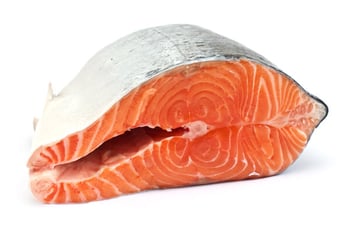
Omega fatty acids support a number of vital systems in the body. Both Omega 3 and 6 fatty acids will support skin and coat health benefits, regulate inflammation, and support cognitive function. Animal fat does contain a healthy source of these fatty acids, but adding a little extra can help to reduce common skin and digestion problems.
Adding fish and fish oils into your dog’s raw diet a couple of times per week can greatly impact their overall health. Sardines packed in water or wild-caught salmon oil can be added to their food to provide a natural source of these essential fatty acids.
Rotate different types of omega fatty acids regularly. Plant-based fatty acids like flaxseed or sunflower oils can support skin and coat but don’t contain the same types of fatty acids as animal-based oils, so switch between a few types to get a good variety.
Kelp
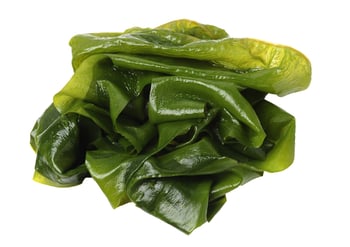
Kelp is nature’s multivitamin, which is why it’s one of the best ways to supplement raw diets. It contains small amounts of all essential vitamins and minerals. It also contains some types of omega fatty acids and amino acids.
Kelp will not replace ingredients or perfectly balance an unbalanced or poorly formulated diet, but it will act as a buffer. When fed a nutritionally balanced diet like the BARF or Whole Prey model, kelp is the perfect way to round out the food and ensure that it’s meeting your dog’s unique needs.
Learn more about the benefits and uses of Kelp for Dogs.
Raw Bones
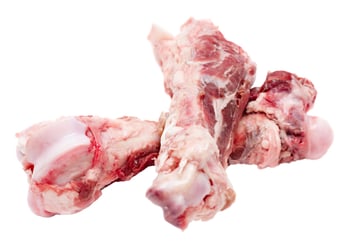
Depending on the type of dog, their age, and their health, providing additional calcium to their diet may be beneficial. Try offering a raw egg, shell included, with their food once or twice a week. This provides both calcium and a highly digestible protein.
For dogs that love to chew, you can feed raw bones. It will not only be a treat that will keep them occupied and healthy but will also increase their calcium intake and care for their dental health.
Avoid bones that are too hard, like weight-bearing bones. These are considered recreational bones, designed for chewing but not consuming.
Instead, go for softer, edible bones that won't splinter, like poultry necks, backs, feet, and wingtips. Poultry bones are higher in calcium than red meat bones, so you won’t need to feed as much. They can be part of the meal or fed as treats.
Is your dog a red meat fanatic? That’s ok too. Some red meat bones are edible and will serve the same purpose as their feathered friends. Look for ribs or necks as a safe edible alternative to dense marrow and femur bones.
Thicker, harder bones have a higher chance of damaging your pet’s teeth, so avoid anything that’s too dense. Many larger bones like beef femurs and soup bones are fine to chew casually, but they aren’t recommended for aggressive chewers that will break pieces off and swallow them.
Always monitor your dog with any type of raw bone. Even the edible ones can be a choking hazard if your dog tries to swallow larger pieces.
How to Make Homemade Dog Food
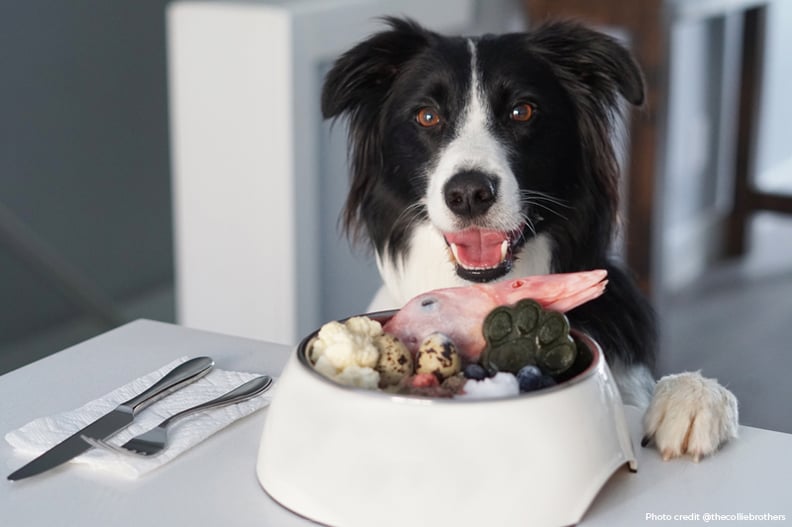
Connect with a holistic or integrative vet to help you formulate a meal plan if you are concerned that your dog has unique needs. It’s always better to be safe than sorry. Getting some expert advice will ensure that you are providing your pup with everything they need to thrive.
Homemade diets can be a bit of trial and error. Don't be afraid to try new ingredients (dog safe) and keep track of what works and what doesn't.
Keeping a journal of your homemade recipes, your dog's bowel movement, and their taste preferences will help you narrow down your recipes to the ones you know work well.
Just like switching to any other diet format, a gradual transition is always recommended. Going from a processed diet like kibble to a raw diet can be difficult on your dog's system, so take the appropriate steps to introduce the new food.
To learn a few different methods of chicken hearts, check out Transitioning Your Dog to a Natural Raw Dog Food Diet.
FAQs About Homemade Raw Dog Food
What is complete and balanced homemade raw dog food?
Complete and balanced homemade raw dog food refers to a diet that provides all the necessary nutrients, vitamins, and minerals in the right proportions to meet a dog's nutritional requirements without the need for additional supplements.
Why should I consider making homemade raw dog food?
Making homemade raw dog food allows you to have more control over your dog's diet, ensuring high-quality ingredients and catering to any specific dietary needs or allergies.
How can I ensure that my homemade raw dog food is balanced?
To achieve balance, include a variety of protein sources (meat, organs, and bones) and fresh veggies and fruits. Use our homemade raw food calculator to ensure appropriate ratios of each ingredient.
Can I use raw ingredients from my local grocery store?
You can use raw ingredients from your local grocery store. Sourcing high-quality, human-grade meats and vegetables is crucial to ensure your dog's safety and health.
Are there any safety concerns when preparing homemade raw dog food?
Yes, safety concerns include handling raw meat properly to prevent contamination, keeping surfaces clean, and ensuring that your dog's diet is properly balanced.
How do I transition my dog to a complete and balanced homemade raw food diet?
Transition gradually by mixing small amounts of homemade raw food with your dog's current raw diet, increasing the proportion of homemade food over several days to adjust your dog's digestive system.
.png?width=200&height=66&name=logo%20(1).png)




.jpg)

